Experimental and Numerical CFD Modelling of the Hydrodynamic Effects Induced by a Ram Pump Waste Valve
Abstract
:1. Introduction
1.1. The Hydraulic Ram Pump or Hydram
- To raise water from a water source to a target community;
- To withstand external aggressions such as weather, rain, mud, organic matter, shocks, thefts and landslides;
- To withstand internal fatigue due to the impact of the water hammer effect.
- A sufficient water source;
- A slope towards the pump;
- A physically possible high delivery in interaction with the headstock;
- A realistic amount of water to pump.
- The use of a renewable energy source that guarantees low running costs;
- The ability to pump only a small part of the available flow, with the possibility of returning the ejected water to the source, ensuring minimum environmental impact;
- Simplicity and reliability of the device and low maintenance requirements;
- Good potential for local production in rural villages;
- Automatic and continuous operation, not requiring human input.
- The pump is limited to hilly areas with water sources present all year round (the lack of an adequate water supply flow rate would result in an inevitable shutdown of the pump);
- It pumps only a small part of the available flow and, therefore, requires a much larger source capacity than the volume of water to be delivered;
- It can have a high design and installation cost compared to other technologies (especially in those countries where it is difficult to find the necessary components);
- It is generally limited to small-scale applications, typically up to 1KW, although technological progress has made it possible to design ram pumps with greater power.
1.2. Analysis of the Literature
1.3. Aim of the Present Study
2. Laboratory Experimental Plant
- Two hydraulic pressure transmitters, model Trafag NAH 8253®, pressure range 0–2.5 bar (overpressure 5 bar), pressure accuracy 0.15%, sampling rate 1 kHz. Of Wheatstone bridge type, they relate the induced deformation undergone by a membrane to a potential difference proportional to the exerted pressure;
- Two shielded electrical plugs m 12 × 1,5-pole for the electrical connection of the transducers;
- Data acquisition (DAQ) hardware consisting of the National Instruments (NI) cDAQ-9174® hub, hosting the sampling modules NI 9218® and NI 9220®;
- A digital camera, model AOS AOS Q-PRI with a sampling rate of 1 kHz, provided with a 3mp sensor.
3. Numerical Analysis
3.1. CFD
3.2. CFD Modelling of the Waste Valve
- Definition of geometry;
- Definition of mesh;
- Setup;
- Solutions and results.
3.3. Geometry Definition
3.4. Definition of the Mesh
3.5. ANSYS Fluent Settings for Simulations
- represents the kinetic energy generation of turbulence due to average speed gradients;
- is the kinetic energy generation of turbulence due to buoyancy;
- represents the contribution of the fluctuating expansion of compressible turbulence to the overall dissipation rate;
- = 1.44, = 1.92 and = −0.33 are the model constants;
- = 1 and = 1.3 are the Prandtl turbulence parameters for k and ε, respectively;
- and are user-defined source terms, not included here.
4. Simulations and Analysis of the Results
4.1. List of Performed Simulations
4.2. Velocity and Pressure Analysis for Scenario 1
4.3. Pressure Analysis for Scenario 2
4.4. Pressure Analysis: Simulation 3
4.5. Pressure Analysis: Simulation 4
4.6. Comprehensive Analysis of the Results for All Scenarios
5. Conclusions
Author Contributions
Funding
Institutional Review Board Statement
Informed Consent Statement
Data Availability Statement
Conflicts of Interest
References
- Clark, J. Hydraulic Rams: Their Principles and Construction; Batsford: London, UK, 1900. [Google Scholar]
- Anderson, E.W. Hydraulic Rams. Proc. Inst. Mech. Eng. 1922, 102, 337–355. [Google Scholar] [CrossRef]
- Iversen, H.W. An analysis of the hydraulic ram. J. Fluid Eng. 1975, 97, 191–196. [Google Scholar] [CrossRef]
- Young, B.W. Generic design of ram pumps. Proc. Inst. Mech. Eng. Part A J. Power Energy 1998, 212, 117–124. [Google Scholar] [CrossRef]
- Young, B.W. Simplified analysis and design of the hydraulic ram pump. Proc. Inst. Mech. Eng. Part A J. Power Energy 1996, 210, 295–303. [Google Scholar] [CrossRef]
- Krol, J. The Automatic Hydraulic Ram. Proc. Inst. Mech. Eng. 1951, 165, 53–73. [Google Scholar] [CrossRef]
- O’brien, M.P.; Gosline, J.E. The Hydraulic Ram; University of California Publications in Engineering: Berkeley, CA, USA, 1933. [Google Scholar]
- Basfeld, M.; Müller, E. The hydraulic ram. Forsch. Ingenieurwesen 1984, 50, 141–147. [Google Scholar] [CrossRef]
- Calvert, N.G. Drive Pipe of a Hydraulic Ram. In The Engineer; Harmsworth Press: London, UK, 1958. [Google Scholar]
- Schiller, E.J.; Kahangire, P. Analysis and computerized model of the automatic hydraulic ram pump. Can. J. Civ. Eng. 1984, 11, 743–750. [Google Scholar] [CrossRef]
- Mathewson, L. The rebirth of the hydraulic ram pump. Waterlines 1993, 12, 10–14. [Google Scholar] [CrossRef]
- Najm, H.N.; Azoury, P.H.; Piasecki, M. Hydraulic ram analysis: A new look at an old problem. Proc. Inst. Mech. Eng. Part A J. Power Energy 1999, 213, 127–141. [Google Scholar] [CrossRef]
- Verspuy, C.; Tijsseling, A.S. Hydraulic ram analysis. J. Hydraul. Res. 1993, 31, 267–278. [Google Scholar] [CrossRef]
- Young, B.W. Design of hydraulic ram pump systems. Proc. Inst. Mech. Eng. Part A J. Power Energy 1995, 209, 313–322. [Google Scholar] [CrossRef]
- Othman, M.; Halimee, N.F.H.A.; Sobri, M.N.M.; Suif, Z.; Ahmad, N. Hydraulic Ram Pump: A practical solution for green energy. In Sustainable Development of Water and Environment; Springer International Publishing: Berlin/Heidelberg, Germany, 2020. [Google Scholar] [CrossRef]
- Li, J.; Yang, K.; Guo, X.; Huang, W.; Shi, C.; Guo, Y.; Wang, T.; Fu, H.; Pan, J. Mathematical model of hydraulic ram pump system. Proc. Inst. Mech. Eng. Part A J. Power Energy 2022, 236, 1097–1108. [Google Scholar] [CrossRef]
- Filipan, V.; Virag, Z.; Bergant, A. Mathematical modelling of a hydraulic ram pump system. J. Mech. Eng. 2003, 4, 137–149. [Google Scholar]
- Pathak, A.; Deo, A.; Khune, S.; Mehroliya, S.; Pawar, M.M. Design of hydraulic ram pump. Int. J. Innov. Res. Sci. Technol. 2016, 2, 290–293. [Google Scholar]
- Sharma, A.M.; Banerjee, D.K.; Pidugu, S.B. Effect of flapper valve on the performance of a hydraulic ram pump. In Proceedings of the ASME 2022 International Mechanical Engineering Congress and Exposition, Columbus, OH, USA, 30 October–3 November 2022. [Google Scholar] [CrossRef]
- Sharma, A.M.; Jackson, J.H.; Centeno, P.J.; Pidugu, S.B. Effect of source tank configuration on the performance of a hydraulic ram pump. In Proceedings of the ASME 2021 International Mechanical Engineering Congress and Exposition, Online, 1–5 November 2021. [Google Scholar] [CrossRef]
- Suarda, M.; Ghurri, A.; Sucipta, M.; Kusuma, I.G.W.K. Investigation on characterization of waste valve to optimize the hydraulic ram pump performance. In Proceedings of the International Conference on Thermal Science and Technology (ICTST) 2017, Bali, Indonesia, 17–19 November 2017; Volume 020023. [Google Scholar] [CrossRef]
- Suarda, M.; Sucipta, M.; Dwijana, I.G.K. Investigation on flow pattern in a hydraulic ram pump at various design and setting of its waste valve. In Proceedings of the IOP Conference Series: Materials Science and Engineering, Bali, Indonesia, 24–25 October 2018; Volume 539, p. 012008. [Google Scholar] [CrossRef]
- Sucipta, M.; Suarda, M. Investigation and analysis on the performance of hydraulic ram pump at various design its snifter valve. In Proceedings of the IOP Conference Series: Materials Science and Engineering, Bali, Indonesia, 24–25 October 2018; Volume 539, p. 012007. [Google Scholar] [CrossRef]
- Guo, X.; Li, J.; Yang, K.; Fu, H.; Wang, T.; Guo, Y.; Xia, Q.; Huang, W. Optimal design and performance analysis of hydraulic ram pump system. Proc. Inst. Mech. Eng. Part A J. Power Energy 2018, 232, 841–855. [Google Scholar] [CrossRef]
- Asvapoositkul, W.; Juruta, J.; Tabtimhin, N.; Limpongsa, Y. Determination of hydraulic ram pump performance: Experimental results. Adv. Civ. Eng. 2019, 2019, 9702183. [Google Scholar] [CrossRef]
- Fatihhi Januddi, F.S.; Huzni, M.M.; Effendy, M.S.; Bakri, A.; Zulhaimi, M.; Zuhaila, I. Development and testing of hydraulic ram pump (Hydram): Experiments and simulations. In Proceedings of the IOP Conference Series: Materials Science and Engineering 2018, International Fundamentum Science Symposium 2018, Terengganu, Malaysia, 25–26 June 2018; Volume 440, p. 012032. [Google Scholar] [CrossRef]
- Manohar, K.; Adeyanju, A.A.; Vialva, K. Predicting the output of a hydraulic ram pump. Curr. J. Appl. Sci. Technol. 2019, 38, 1–7. [Google Scholar] [CrossRef]
- Harith, M.N.; Bakar, R.A.; Ramasamy, D.; Quanjin, M. A significant effect on flow analysis & simulation study of improve design hydraulic pump. In Proceedings of the IOP Conference Series: Materials Science and Engineering 2017, 4th International Conference on Mechanical Engineering Research (ICMER2017), Swiss Garden Beach Resort, Kuantan, Pahang, Malaysia, 1–2 August 2017; Volume 257, p. 012076. [Google Scholar] [CrossRef]
- Asvapoositkul, W.; Nimitpaitoon, T.; Rattanasuwan, S.; Manakitsirisuthi, P. The use of hydraulic ram pump for increasing pump head-technical feasibility. Eng. Rep. 2021, 3, e12314. [Google Scholar] [CrossRef]
- Fatahi-Alkouhi, R.; Lashkar-Ara, B.; Keramat, A. On the measurement of ram-pump power by changing in water hammer pressure wave energy. Ain Shams Eng. J. 2019, 10, 681–693. [Google Scholar] [CrossRef]
- Yussupov, Z.; Yakovlev, A.; Sarkynov, Y.; Zulpykharov, B.; Nietalieva, A. Results of the study of the hydraulic ram technology of water lifting from watercourses. Int. J. Eng. Sci. 2022, 177, 103713. [Google Scholar] [CrossRef]
- Zeidan, M.; Ostfeld, A. Hydraulic ram pump integration into water distribution systems for energy recovery application. Water 2022, 14, 21. [Google Scholar] [CrossRef]
- Pawlick, M.; Vaughn, D.; Plumblee, J. Determining Hydraulic Ram Pump Feasibility. J. Humanit. Eng. 2022. [Google Scholar] [CrossRef]
- Celerinos, P.J.S.; Sanchez-Companion, K.D. Determination of critical delivery head for hydraulic ram pump. Mindanao J. Sci. Technol. 2022, 20, 1–29. [Google Scholar]
- Widiarta, I.P.; Suarda, M.; Sukadana, I.G.K.; Sucipta, M.; Suantini, N.M.; Suweden, I.N. Study on the waste valve’s stroke to water hammer pressure and flow patterns in a hydraulic ram pump. In Proceedings of the 2nd International Conference on Design, Energy, Materials and Manufacture 2021 (ICDEMM 2021), AIP Conference Proceedings, Pekanbaru, Indonesia, 4 August 2021; AIP Publishing: Melville, NY, USA, 2023; Volume 2568, p. 030014. [Google Scholar] [CrossRef]
- Handa, C.C.; Valvi, V.; Sahare, M.; Ingole, P.; Samarth, T.; Kumbhare, S.; Raut, A. Development of Hydraulic Ram Pump for Agriculture Uses and Approach A Review. Int. J. Res. Appl. Sci. Eng. Technol. (IJRA) 2023, 11. Available online: www.ijraset.com (accessed on 15 July 2023). [CrossRef]
- Viccione, G.; Immediata, N.; Cava, R.; Piantedosi, M. A preliminary laboratory investigation of a hydraulic ram pump. In Proceedings of the EWaS3 2018, 3rd EWaS International Conference on “Insights on the Water-Energy-Food Nexus”, Lefkada Island, Greece, 27–30 June 2018; Volume 2, p. 687. [Google Scholar] [CrossRef]
- ANSYS, Inc. ANSYS Fluent 14.5, Tutorial Guide; ANSYS, Inc.: Canonsburg, PA, USA, 2012. [Google Scholar]
- Bergamo, U.; Viccione, G.; Coppola, S.; Landi, A.; Meda, A.; Gualtieri, C. Analysis of anaerobic digester mixing: Comparison of long shafted paddle mixing vs. gas mixing. Water Sci. Technol. 2020, 81, 1406–1419. [Google Scholar] [CrossRef]


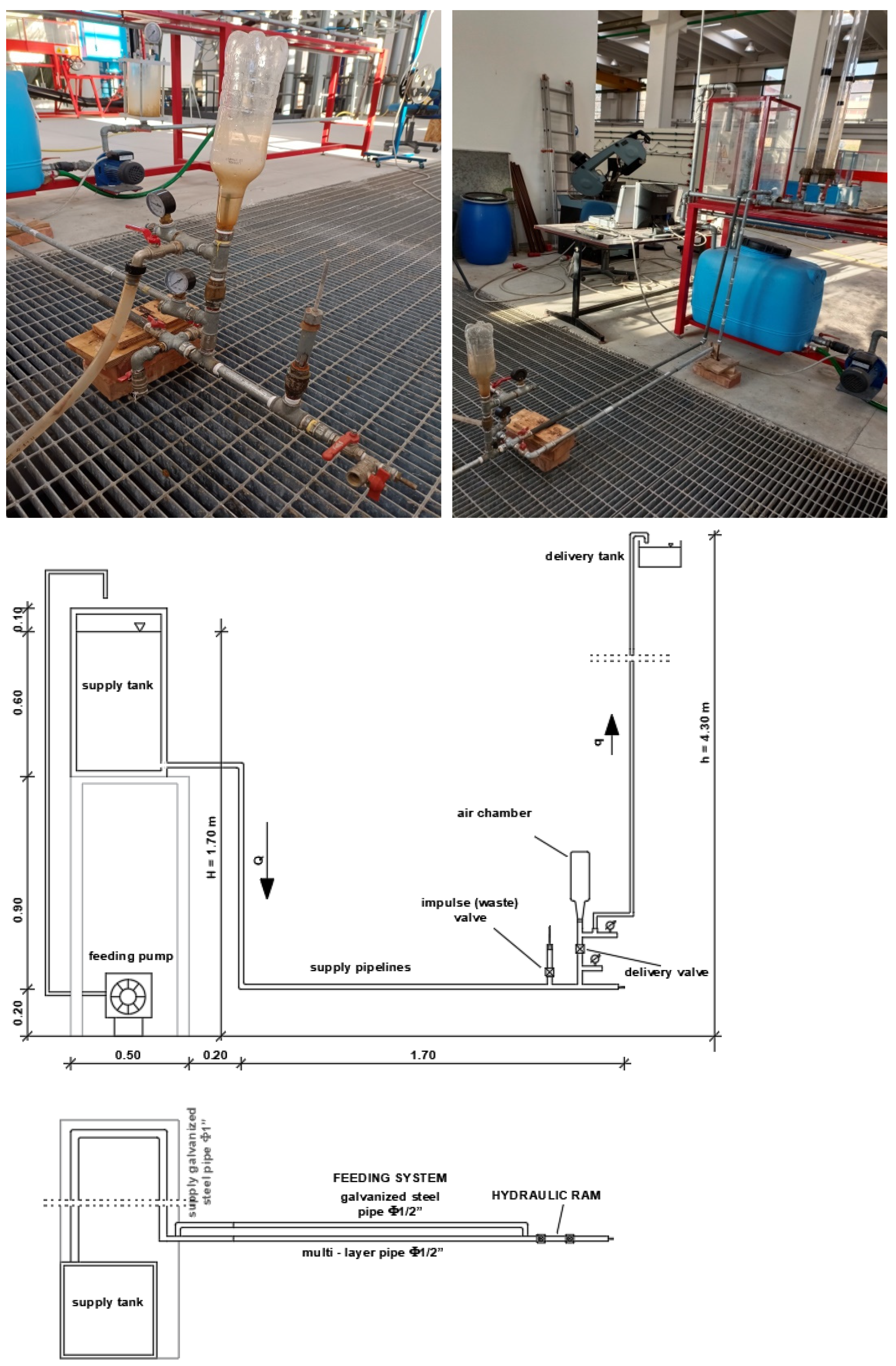

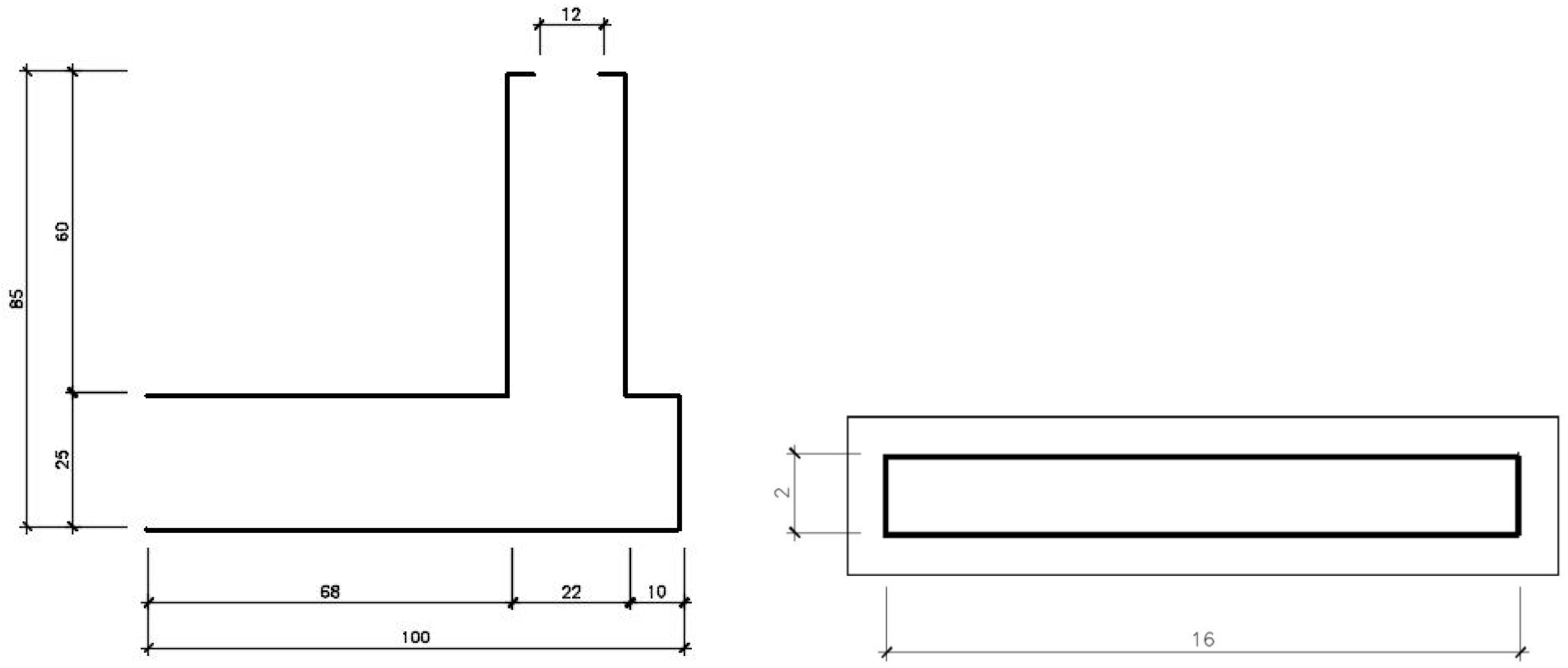


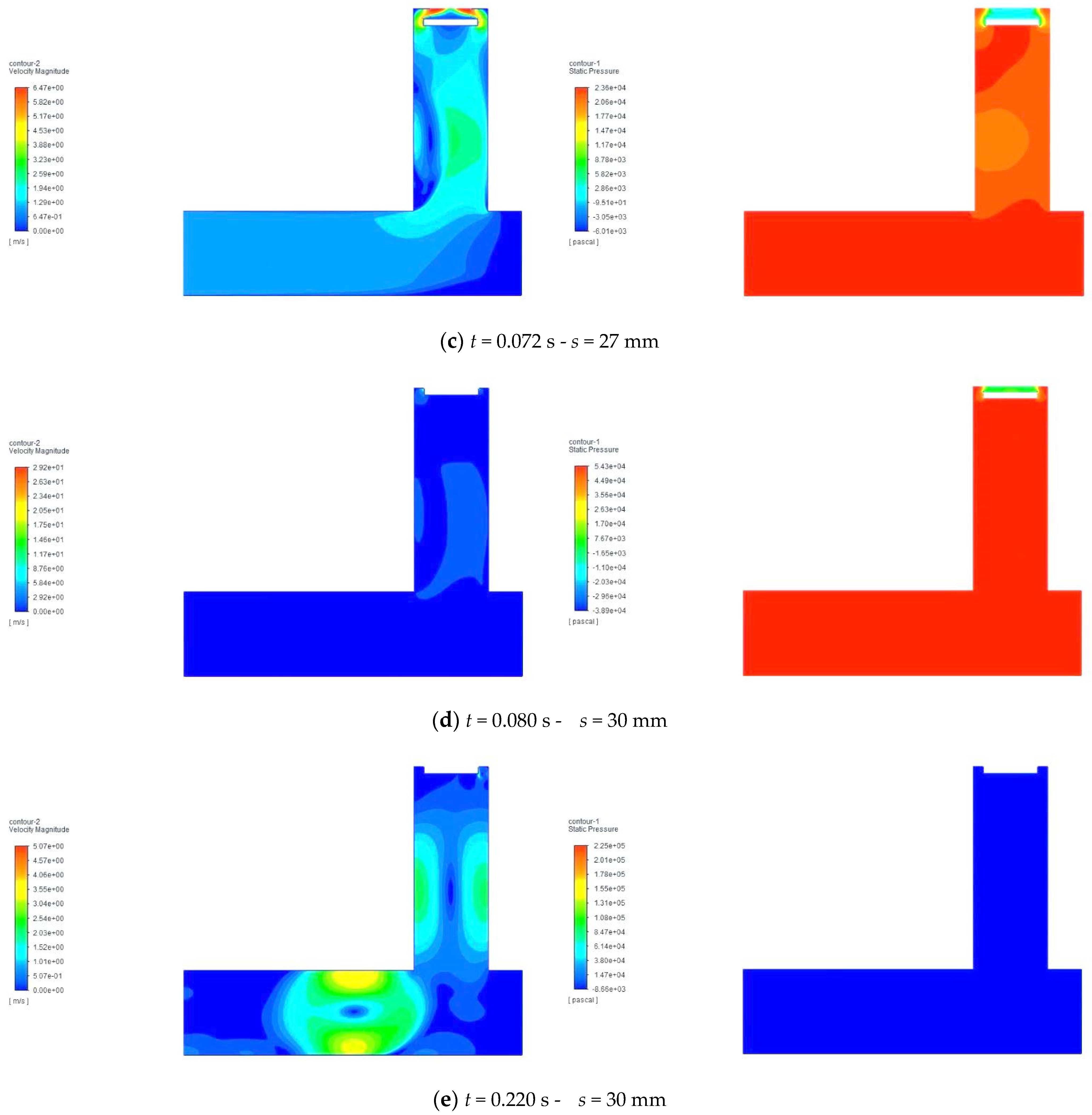
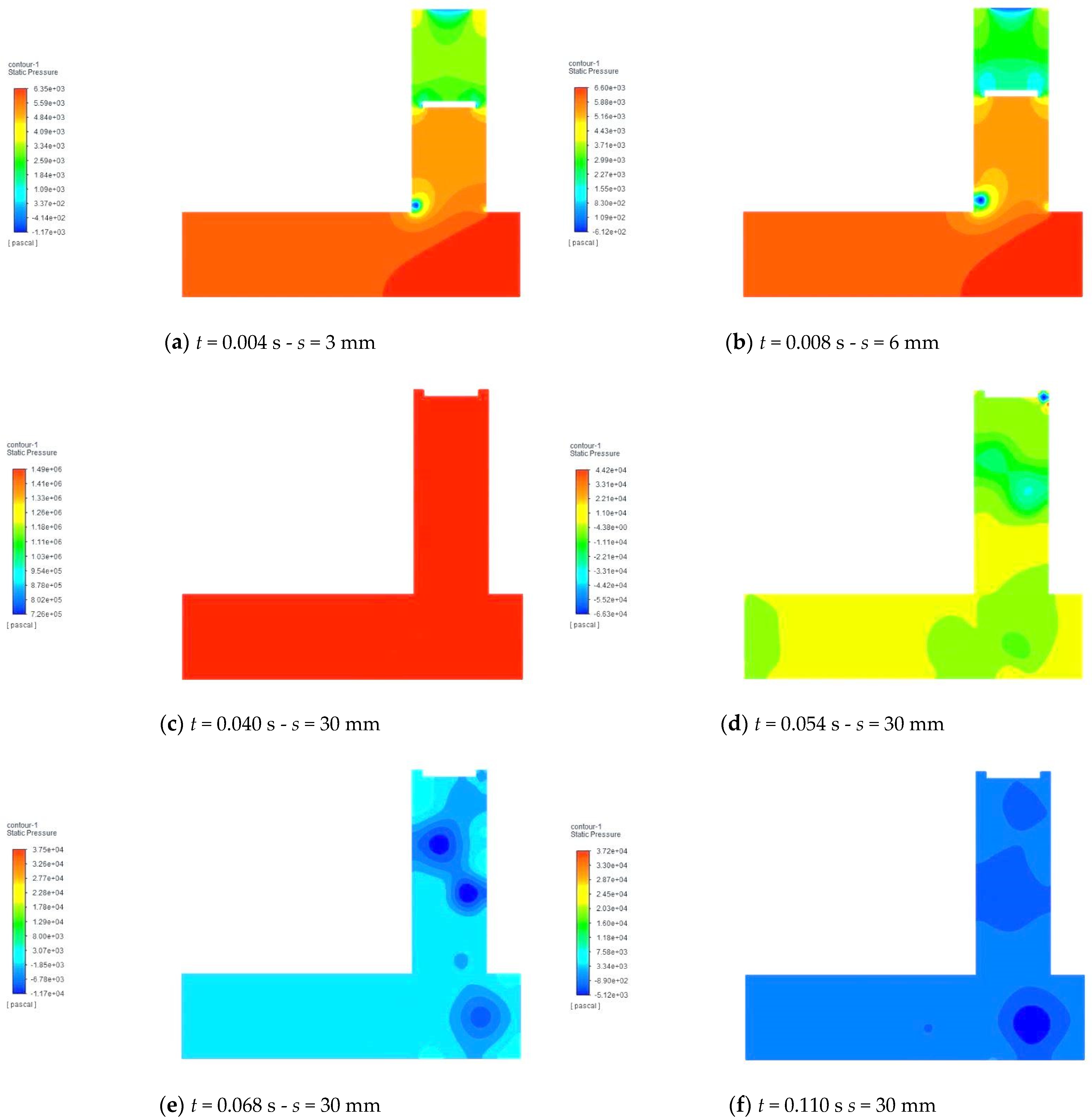



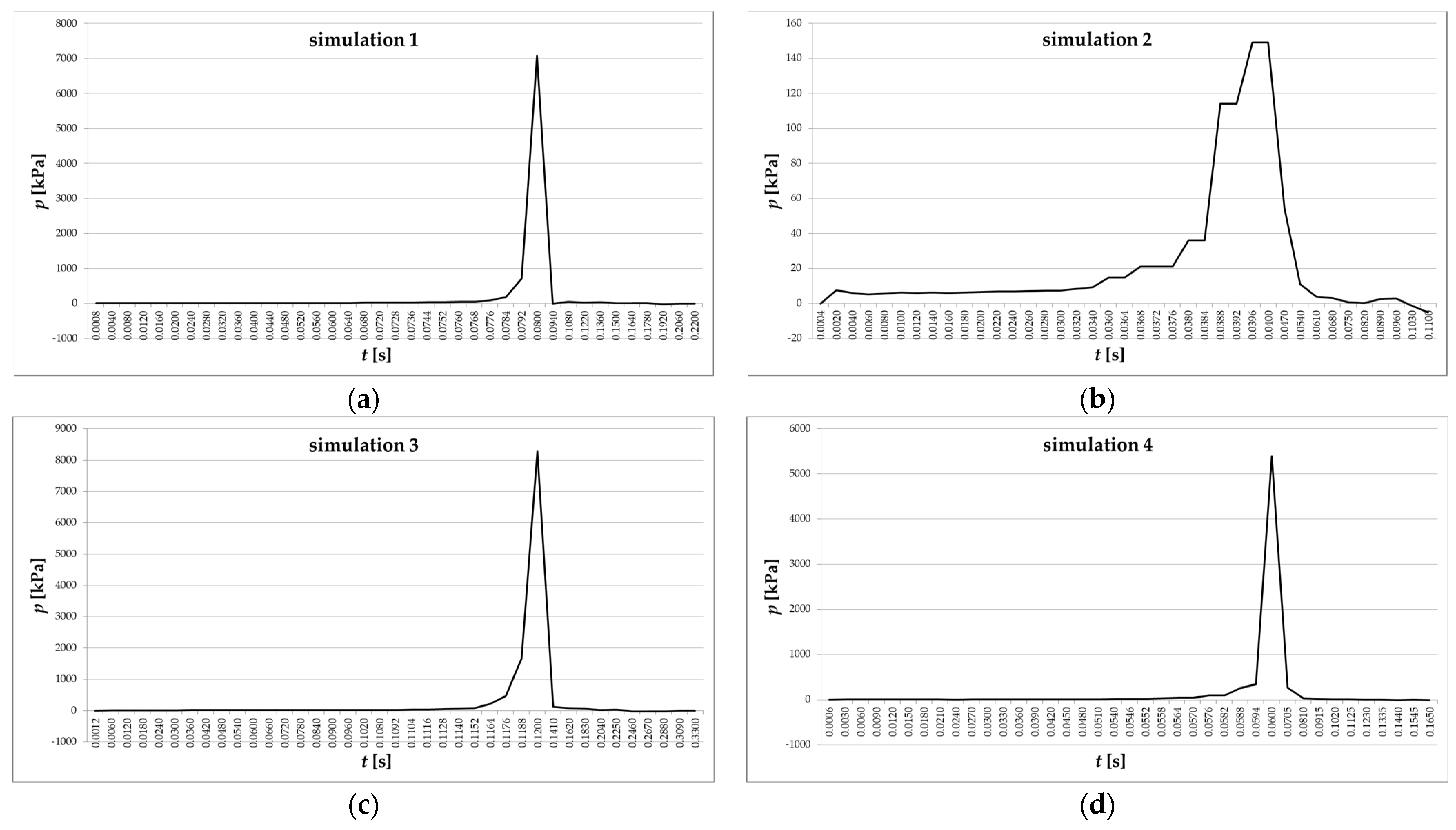
| Scenario | smax (m) | tclosing (s) | Vpiston (m/s) | Vmax_outlet (m/s) | Δp_Jmin (Pa) | Δp_Jmax (Pa) |
|---|---|---|---|---|---|---|
| 1 | 0.03 | 0.08 | 0.375 | 29.20 | 5.25 × 105 | 4.09 × 107 |
| 2 | 0.03 | 0.04 | 0.75 | 58.40 | 1.05 × 106 | 8.18 × 107 |
| 3 | 0.03 | 0.12 | 0.25 | 38.93 | 3.50 × 105 | 5.45 × 107 |
| 4 | 0.03 | 0.06 | 0.5 | 51.91 | 7.00 × 105 | 7.27 × 107 |
Disclaimer/Publisher’s Note: The statements, opinions and data contained in all publications are solely those of the individual author(s) and contributor(s) and not of MDPI and/or the editor(s). MDPI and/or the editor(s) disclaim responsibility for any injury to people or property resulting from any ideas, methods, instructions or products referred to in the content. |
© 2023 by the authors. Licensee MDPI, Basel, Switzerland. This article is an open access article distributed under the terms and conditions of the Creative Commons Attribution (CC BY) license (https://creativecommons.org/licenses/by/4.0/).
Share and Cite
Evangelista, S.; Tortora, G.; Viccione, G. Experimental and Numerical CFD Modelling of the Hydrodynamic Effects Induced by a Ram Pump Waste Valve. Sustainability 2023, 15, 13104. https://doi.org/10.3390/su151713104
Evangelista S, Tortora G, Viccione G. Experimental and Numerical CFD Modelling of the Hydrodynamic Effects Induced by a Ram Pump Waste Valve. Sustainability. 2023; 15(17):13104. https://doi.org/10.3390/su151713104
Chicago/Turabian StyleEvangelista, Stefania, Giuseppe Tortora, and Giacomo Viccione. 2023. "Experimental and Numerical CFD Modelling of the Hydrodynamic Effects Induced by a Ram Pump Waste Valve" Sustainability 15, no. 17: 13104. https://doi.org/10.3390/su151713104








